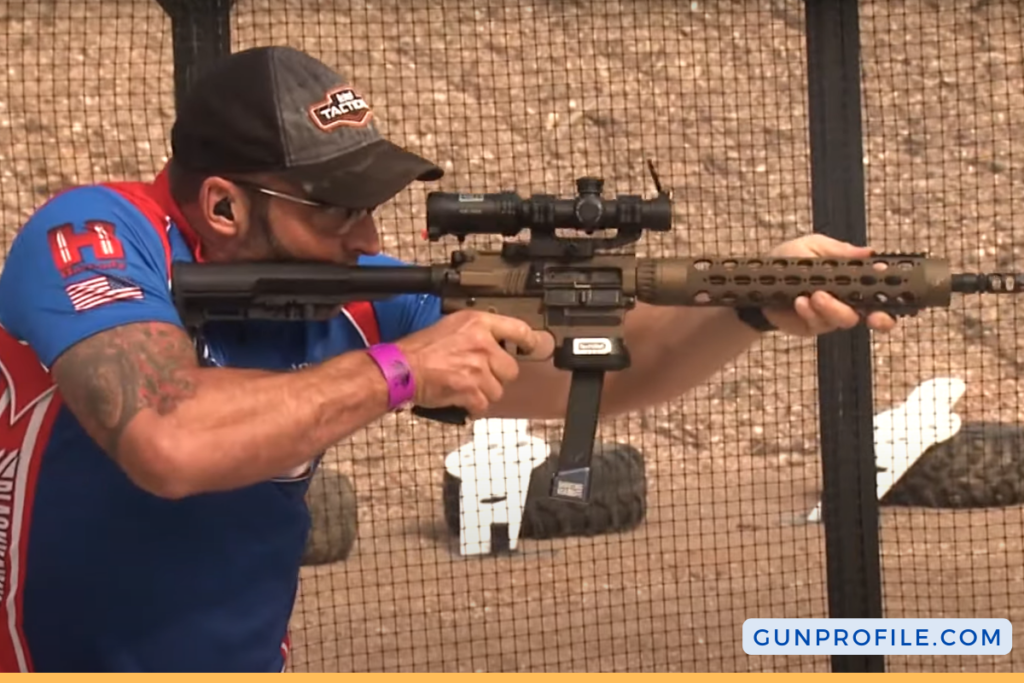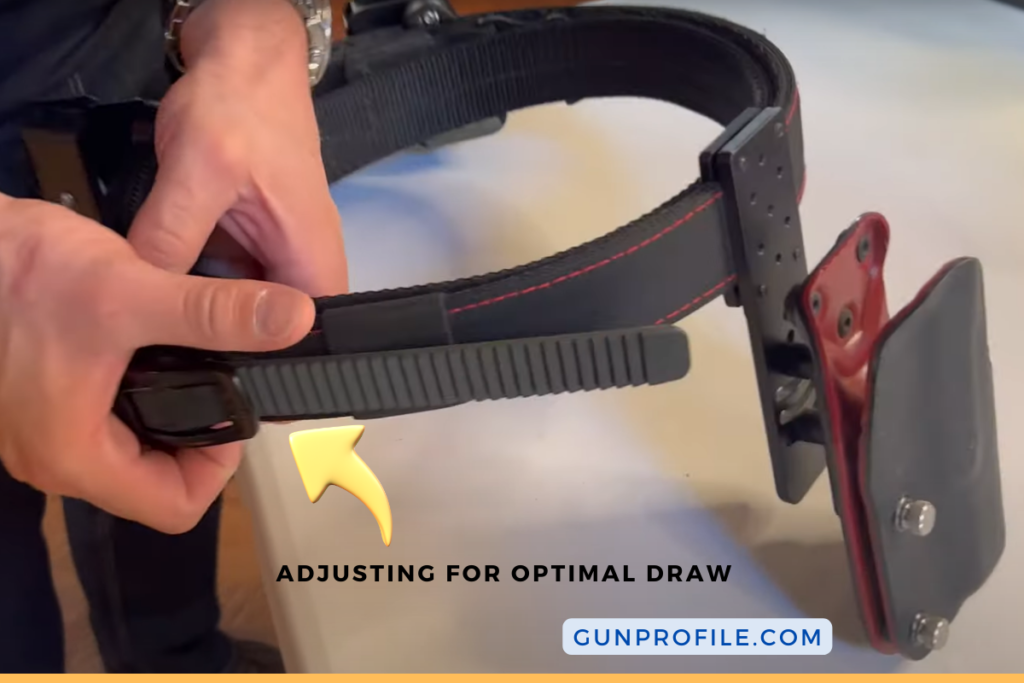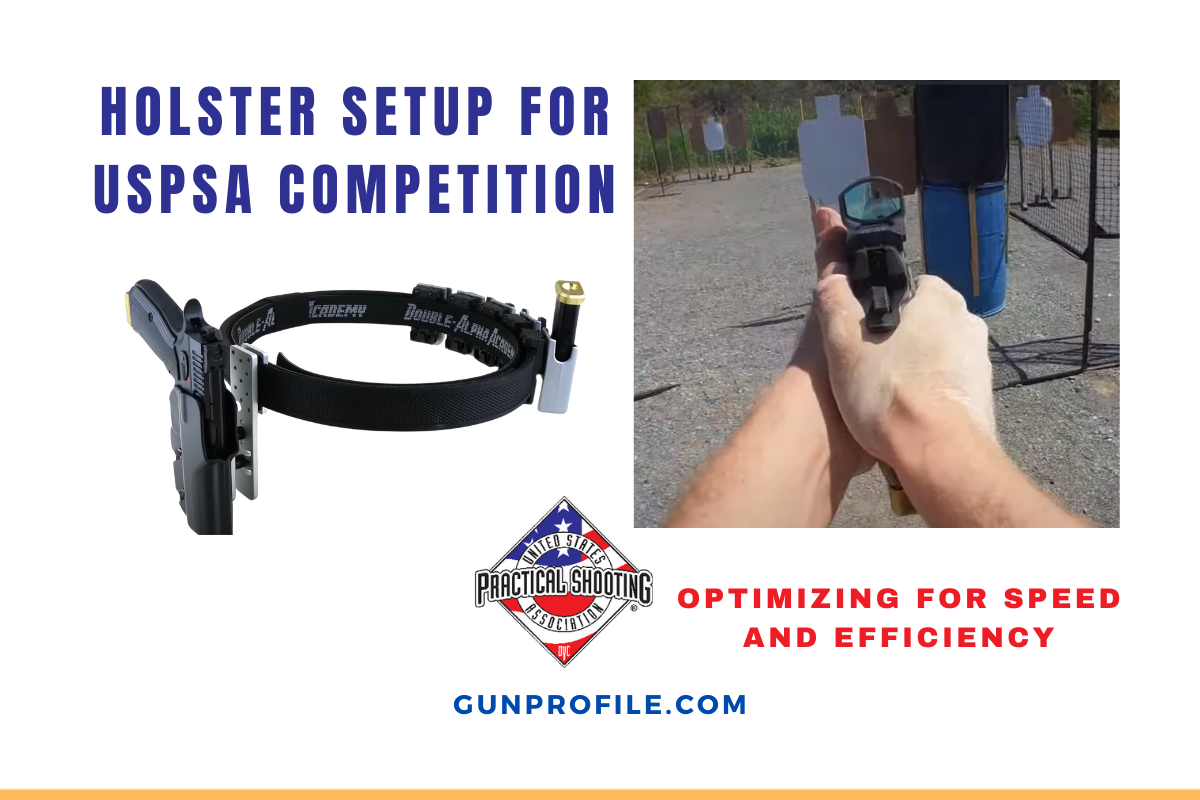Holster Setup for USPSA Competition is crucial for any shooter looking to improve their performance. A proper setup not only enhances speed but also ensures efficiency during a match. Setting up your holster correctly for USPSA involves considering factors like the height, angle, and position on the belt.
This guide will walk you through the essentials of optimizing your holster, from angle adjustments to gear placement, to help you shave seconds off your draw and stay ahead of the competition.
Key Takeaways
- A well-chosen holster can markedly improve a shooter’s performance in USPSA competitions.
- Correct holster setup is crucial for efficient draw and re-holstering during matches.
- Additional gear should be considered in tandem with the holster to optimize shooting efficiency.

Understanding USPSA Holster Regulations
In USPSA competition, holster regulations are crucial for safety and fairness. These rules address holster positioning, retention, and acceptable materials, ensuring that all participants adhere to a standard that allows for efficient and secure weapon handling.
Holster Positioning and Height
Holsters must be worn so that the gun is carried at belt level, ensuring that the muzzle points to the ground while the firearm is holstered. Grip of the pistol must be positioned at or above the belt line, with specific divisions like Production and Single Stack having stricter positioning rules that competitors must follow.
Holster Retention Requirements
The holster design must provide adequate retention to prevent the firearm from falling out during any required movement within a stage. Moreover, holsters must cover the trigger of a holstered firearm to minimize the risk of an accidental discharge. Competing in USPSA requires equipment that ensures secure retention of the gun at all times.
Material and Design Restrictions
The materials and overall design of holsters are subject to division-specific regulations. Holsters must be made of a material that can withstand the rigorous conditions of competition. Most importantly, certain types like shoulder holsters or fanny packs are not permissible in USPSA matches. This means that competitors must select a USPSA compliant holster that will not give them a mechanical advantage and is within the material and design guidelines set by the association.
Selecting Right Holster Setup for USPSA Competition
Selecting an appropriate holster is critical for a shooter’s performance in USPSA competitions. Factors such as retention, draw speed, and holster placement significantly affect one’s ability to shoot both accurately and efficiently.
Evaluating Holster Performance
A USPSA holster should facilitate a smooth and fast draw while ensuring the firearm remains secure during vigorous movement. Retention is a key aspect; some holsters provide active retention mechanisms, such as thumb breaks or push-button releases, which can be advantageous for maintaining control over the firearm. The shooter must consider how the holster’s retention system balances security with the ability to quickly draw the firearm during competition.
Comfort and Accessibility
The holster must be comfortable for the shooter to wear throughout the duration of a match, which often involves long periods of standing, moving, and shooting under the stress of competition. Accessibility is also paramount. The holster should allow for a natural hand position and draw stroke. The angle and height at which the holster sits on the belt can greatly impact the draw; thus, these should be adjustable to match the shooter’s ergonomics and shooting stance.
Durability and Maintenance
The construction materials of a holster contribute to its durability and required maintenance. Common materials include Kydex, leather, and nylon. Kydex is popular in USPSA due to its rigidity and low maintenance, while leather may require more care but can offer a classic feel and flexibility. The holster should withstand environmental factors and wear from repeated use. Furthermore, the shooter should examine how easily the holster can be maintained and cleaned, ensuring longevity and consistent performance.
Setting Up Your Holster
Proper holster setup is crucial for a competitor in USPSA to ensure efficient draws and safe reholstering during the competition.
Adjusting for Optimal Draw
The angle at which a holster is set can have a significant impact on the competitor’s draw speed. For a fast and smooth draw, the holster should be positioned so that it’s aligned with the natural motion of the competitor’s arm. For those looking for guidance, a breakdown of how to best set up your holster angle for competition shooting can help achieve this alignment.

Balancing Speed and Security
The tension on the holster must strike a balance: too loose and the firearm may not be secure during movement; too tight and it impedes the draw speed. Competitors often use a rigid belt that allows for a direct holster connection, minimizing movement and maximizing stability. Learning from resources on how to set up a competition belt can assist in finding the right security and speed balance for competition.
Additional Gear Considerations
After selecting the right holster, competitors in USPSA need to consider other gear that can impact performance. The magazine pouches and belt system are vital components that require careful selection and setup to ensure efficiency and compliance with competition standards.
Magazine Pouches and Placement
Magazine pouches must be positioned in a way that allows for swift and smooth magazine changes. Placement is often dictated by division rules; for Production and Single Stack, for example, pouches should be behind the hip bone. A competitor should arrange their magazine pouches to minimize movement and ensure a consistent grip on the magazine. It is crucial to practice with the placement to find the most natural and efficient position.
Belt Selection and Setup
A sturdy belt is foundational for a secure and stable gear setup in USPSA. The belt system usually consists of an inner belt secured through the trouser loops and an outer belt attached via Velcro. This configuration allows the outer belt to carry the weight of magazines and firearm securely. For the belt to work effectively, reinforcement and rigidity are key qualities to look for, as these characteristics help to prevent any sag under the weight of the equipment and support swift holstering and drawing.
Frequently Asked Questions
In the sport of USPSA shooting, competitors must navigate both equipment rules and practical preferences to optimize their gear. The following FAQs address common concerns related to holster choice and setup.
What are the requirements for a holster in USPSA competitions?
The holster must securely retain the firearm, cover the trigger when holstered, point to the ground when the gun is holstered, and be worn at belt level. Shoulder holsters and fanny packs are not allowed in USPSA events.
How do I select the best shooting belt for a USPSA match?
An ideal shooting belt should be rigid enough to hold your gear without sagging. Belts such as those offered by Blade-Tech or Comp-Tac provide the necessary stability and comfort for a USPSA match.
Can you recommend a competition holster that is suitable for a 1911 in USPSA events?
Blade-Tech and Comp-Tac are popular holster manufacturers that produce quality holsters suitable for a 1911. Ensure the holster meets USPSA guidelines.
What are the key differences between IDPA and USPSA holster rigs?
USPSA is generally less restrictive in terms of equipment; for instance, holsters and magazine pouches do not have to be as close to the body as in IDPA. USPSA allows more variety in holster positioning and types, provided they are safe and meet the division requirements.
How should I set up my belt for USPSA Carry Optics division?
For the Carry Optics division, position your holster and magazine pouches on a rigid, stable belt that can support the weight of the gun and loaded magazines. Your setup should allow for quick, smooth draws and reloads.
What features should I look for in a holster to ensure it complies with USPSA Carry Optics rules?
A holster for Carry Optics must retain the firearm securely and position it such that it does not break the vertical plane when drawing. The holster should also provide sufficient protection to the trigger and allow for a clear draw path.

